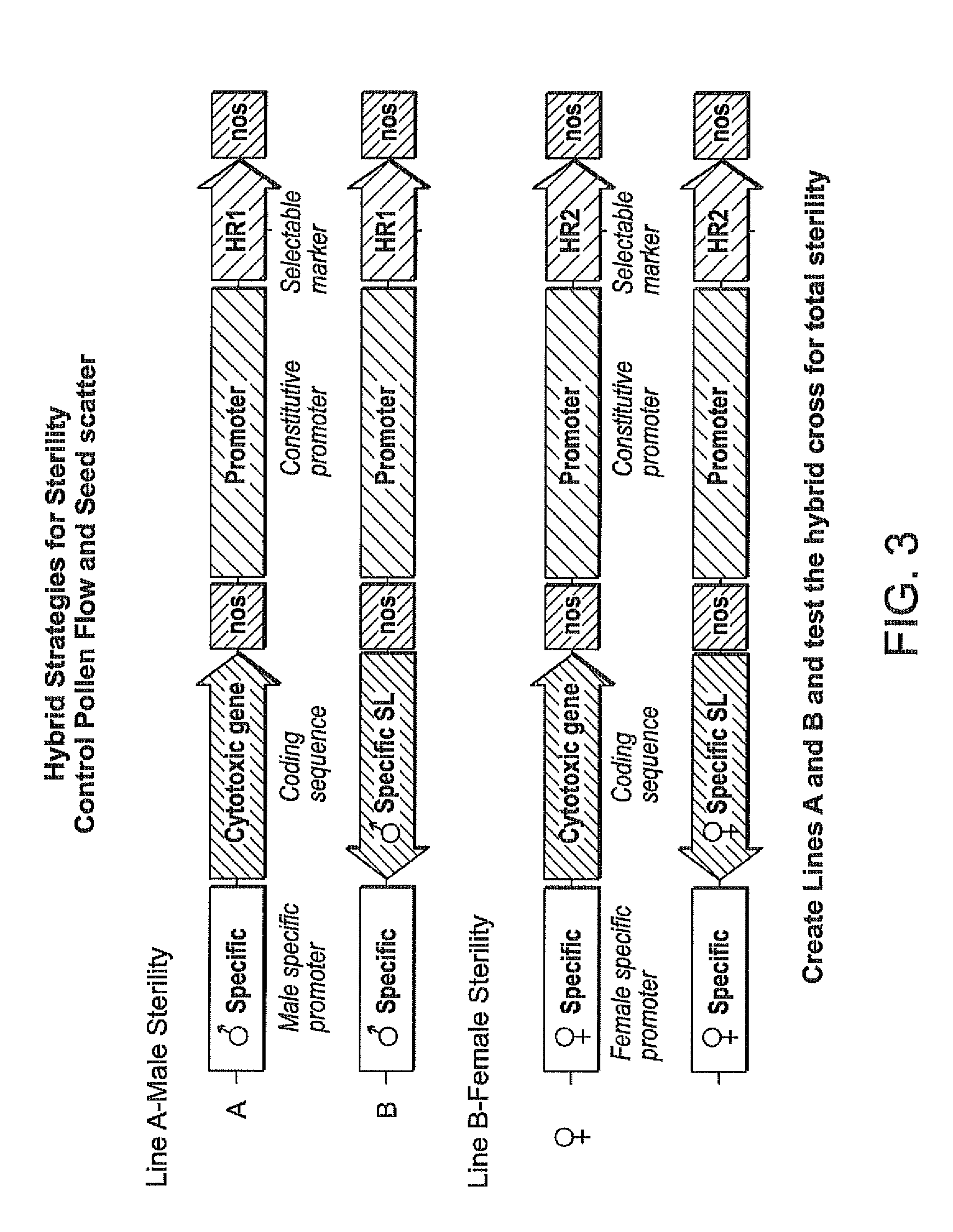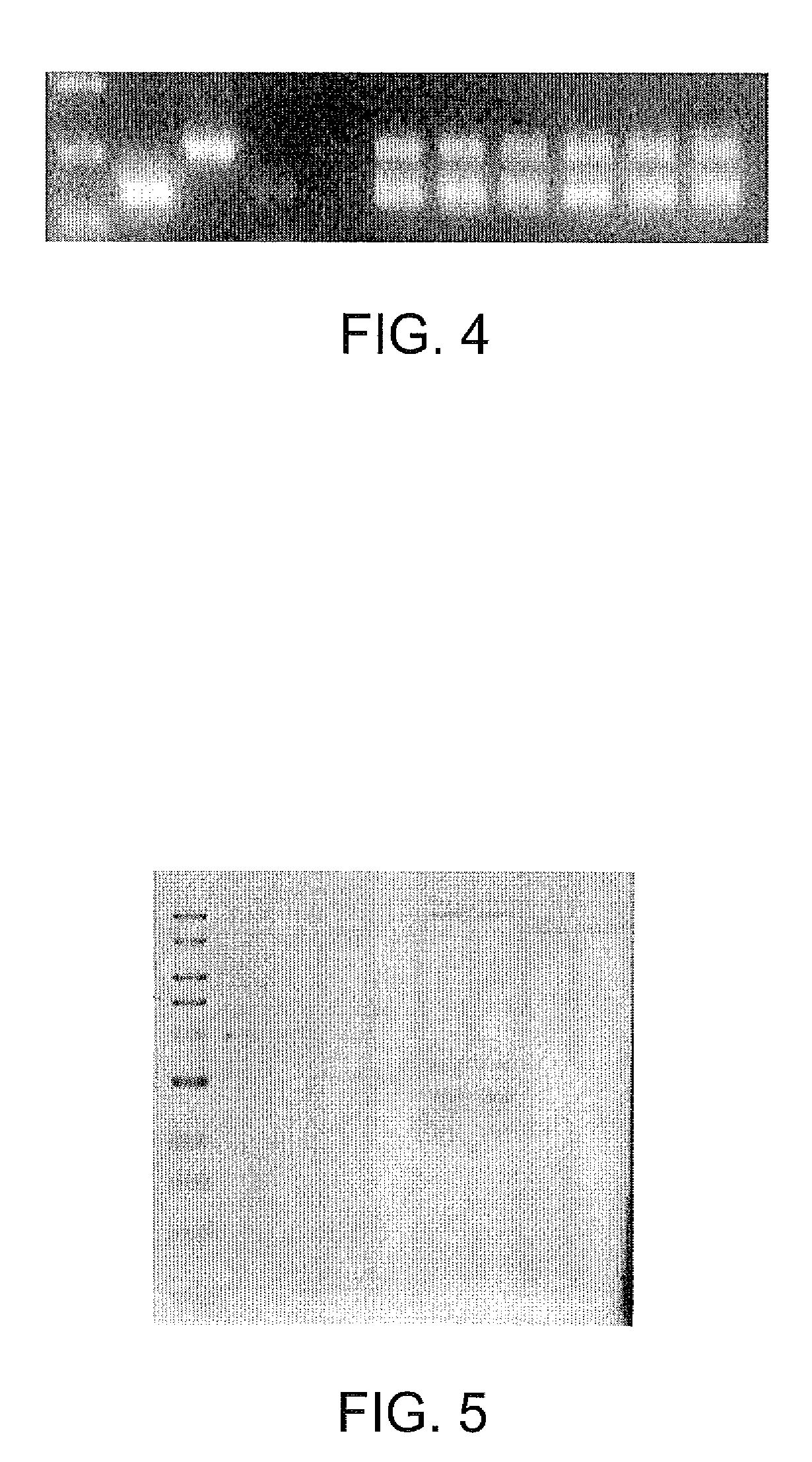Male and female sterility lines used to make hybrids in genetically modified plants
a technology of genetically modified plants and sterility lines, applied in the field of plant genome modification methods, can solve the problems of no field test or commercial practice of these methods, no method has been applied in the field, and no method has been tested or reduced to commercial practice, etc., to achieve the effect of facilitating the breeding process
- Summary
- Abstract
- Description
- Claims
- Application Information
AI Technical Summary
Benefits of technology
Problems solved by technology
Method used
Image
Examples
example 1
Expression of Tapetum Specific Disruption in Switchgrass Results in Impaired Male Fertility
[0109]This example describes methods used to develop transgenic male impaired fertility switchgrass and provides the basis for targeted gene disruption to cause male sterility. Similar methods can be used to produce other transgenic male sterile perennials. The male sterile plants produced prevent outcrossing thus preventing gene flow in plants such as switchgrass that are obligate outcrossers. Also, male sterility combined with herbicide resistance provides a basic breeding tool allowing the selection of rare outcrossing events between distant heterotic groups. Briefly, switchgrass cells are transformed with DNA sequences that cause herbicide resistance and male sterility using the SL technology. As a control and first proof of concept, a construct a construct comprising the tapetum specific promoter driving the expression of the cytotoxic gene (barnase) has been introduced and analyzed in tr...
example 2
Generation of Targeted Mutations Using SL Yields Male Sterile and Female Sterile Plants which Segregate Away from the Selectable Marker Gene
[0122]This example describes methods used to develop transgenic male and female plants with impaired fertility and provides the basis for targeted gene disruption to cause hybrid sterility. Similar methods can be used to produce other transgenic male or female sterile perennial plants. In both male and female sterile lines the transgene cassette can be segregated from the disrupted gene target of maintained in the population by selection. The segregated sterile plants can be used for breeding purposes. Thus, sterility combined with herbicide resistance provides a basic breeding tool allowing the selection of rare outcrossing events between distant heterotic groups. The sterile hybrid plants produced from these crosses prevent outcrossing thus preventing gene flow in plants such as switchgrass that are obligate outcrossers as well as seed scatter...
example 3
[0130]In the third example, the method includes contacting a plant, or plant cell, with a vector, wherein the vector includes a construct to express zinc finger nucleases specific to either male or female floral specific gene(s), including those described above, operably linked to a plant promoter and including a gene of interest (GOI) targeted to disrupt the floral specific genes. The plant promoter may be operably linked to a tissue specific promoter or can be constitutively expressed. The production of transgenics may or may not include the use of a selectable marker gene, but the preferred example is using selection. In this example the expression of the SL complex is delayed by the interruption of expression by using the selectable marker as a blocking fragment flanked by site specific recombination sites, such as frt sequences or their mutant derivatives. The advantage of this strategy is that both male and female lines remain fertile until later expressed. This method of prod...
PUM
| Property | Measurement | Unit |
|---|---|---|
| Fraction | aaaaa | aaaaa |
| Fraction | aaaaa | aaaaa |
| Electrical resistance | aaaaa | aaaaa |
Abstract
Description
Claims
Application Information
 Login to View More
Login to View More - R&D
- Intellectual Property
- Life Sciences
- Materials
- Tech Scout
- Unparalleled Data Quality
- Higher Quality Content
- 60% Fewer Hallucinations
Browse by: Latest US Patents, China's latest patents, Technical Efficacy Thesaurus, Application Domain, Technology Topic, Popular Technical Reports.
© 2025 PatSnap. All rights reserved.Legal|Privacy policy|Modern Slavery Act Transparency Statement|Sitemap|About US| Contact US: help@patsnap.com



